Mixed Up Money
START TRACKING YOUR SPEND
Get to know where you spend, how it makes you feel and what really matters when it comes to your money!
Grab your freebie!
Blog Categories
Let's stop pretending that being good at money means you need to be good at math. Instead, let's listen to our body and our mind.
Hi, I'm Alyssa Davies
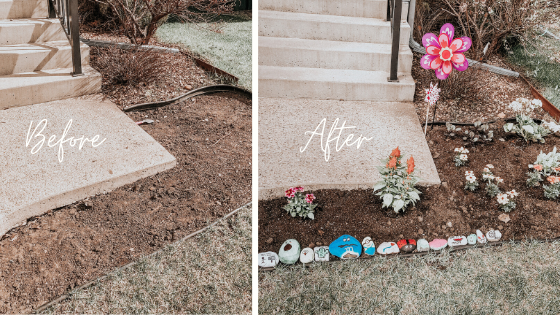
Finally! It’s that time of year when we can spend the majority of our days outside and embrace the sunshine (without harming our precious skin — of course) and embrace our opportunity to grow new life. I’m talking about plants, obviously!
As a new homeowner, I’ve looked forward to having my own garden and growing herbs and vegetables. When I was renting, for some reason, the idea of taking on this responsibility seemed like a poor use of time. Why would I landscape in a place that I won’t be able to continue to maintain for years to come? Of course, if you’re a renter, you can plant and garden. But personally, it wasn’t on my to-do list until now.
I’ll be honest with you in the fact that I’m a complete rookie. Other than helping my mom water and plant flowers as a ‘non-interested’ teenager and doing minor landscaping and planting for a summer job one year, I have no knowledge about what plants work best, how much it might cost and how to start.
So, this guide is for beginners. Plant babies, if you will. Hello, plant babies.
Here are all of the steps I took to put together my first garden.
Step 1 – Consider two essentials: your budget and time
Before I began my hunt for building out a garden, my partner and I discussed the amount of work we were willing to take on. Typically, we don’t have much free time to deadhead and water, but these days, we’re always home. So, that meant that we would be willing to take on more responsibility in a garden than usual.
In the past, the most I’ve spent on gardening was $20 in the Wal-Mart greenhouse to fill one planter with flowers. This time, we knew our budget would be a lot more significant. As a family, we have one fund that is specifically savings for home renovations. We both knew that our garden and outdoor landscaping would fall into this category, so we sat down and agreed we would budget around $300 for our plants, pots, materials and soil. We wanted to buy mostly flowers and only a couple of vegetables. 2020 will be our test year to get a feel for our garden, the sun and rain, and how successful we come to fall.
Ultimately, we’d love to grow fruits and vegetables for the season. It’s an easy decision after doing a bit of reading. An article on the Journal of Extension says that ‘on average, home vegetable gardens produce $677 worth of fruits and vegetables, beyond the cost of $238 worth of materials and supplies.’ This year was strictly about fun colours and an excellent opportunity for our daughter to enjoy some pretty flowers.
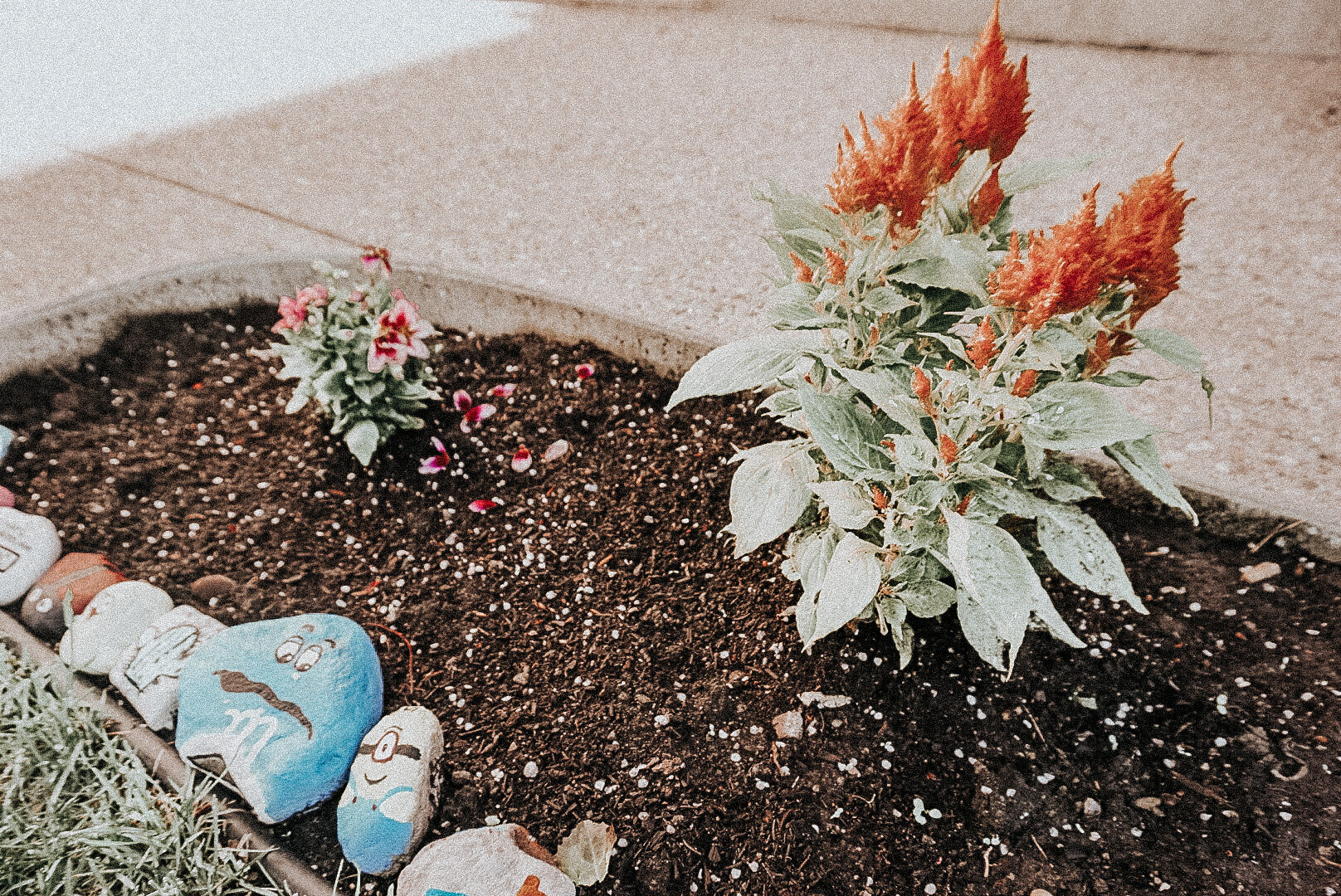
Step 2 – Review and prep your location
Now that we had a set budget in mind, it was time to get an overview of what we were working with. In our house, we had a beautiful front garden bed that needed some serious love. The dirt would need to be worked, and we would need to pull out some rocks and old roots. Our garden is about 6 x 3 feet and gets a ton of direct sunlight.
We also had some room on our front steps for a couple of plant pots that get some direct sunlight, but not all. Although there is room for a garden on the side of our house, it doesn’t receive much sun, and it seems like a lot of work for an area we don’t spend time in. Instead, we figured we’d find some cedar planters that we could put on our deck.
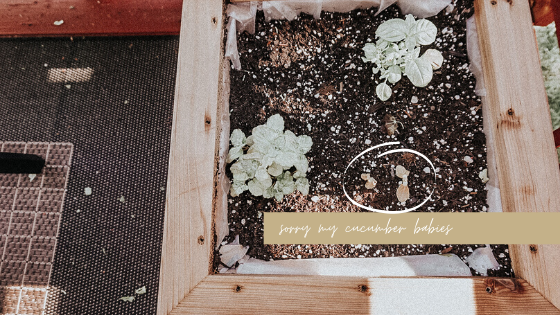
Step 3 – Research your plants (or take a gamble)
The obvious next step would be to go online and look for planters that suit your garden, time constraints, and budget. Unfortunately, I sometimes get impatient and want to be adventurous. So, on a random Saturday, we ventured to a local greenhouse in our community, and with zero ideas of what kind of plants work best for our situation, I picked out everything we would need.
Again, I don’t recommend my way. It was stressful and honestly, overwhelming. Greenhouses are significant, and there are so many different types of plants and flowers, you really should have a general idea of how to take care of each plant before you bring it home.
Step 4 – Buy your plants
We decided to shop locally, given the current economic climate. Rather than buy from a grocery store garden or head to Wal-Mart to buy some plants, we opted for a greenhouse in our community. For this reason, we had to spend a bit more money.
These are the plants we bought:
-
Celosia Bright Sparks
-
Marigold
-
Geranium
-
Dahlinova Florida
-
Calendula
-
Red Cabbage
-
Cucumber (I already killed this one)
-
Mint (thriving)
-
Basil (thriving)
-
Plantain Lily – Hosta (thriving)
Most of the flowers we have are annuals because I wasn’t interested in a long-term plan. As this year was more for feeling things out, it seemed like a great way to quickly gain colour and functionality in our outdoor space.
Step 5 – DIY your garden space
One way we saved money building our first garden was by doing it all ourselves. We enlisted some gardening experts (my parents) and had their support trimming existing bushes and trees. From there, we dug up the garden bed and refreshed the soil using worm poop. Yup, you read that right. Otherwise known as worm castings, this superfood for plants, is also really good at bringing life back to old soil and dirt – which we desperately needed.
Instead of spending part of our budget on decor, we opted to design our own hand-painted rocks as an edge outside of our garden. It’s been a fun and inexpensive hobby over the past few months, which has been great to attempt during the pandemic.
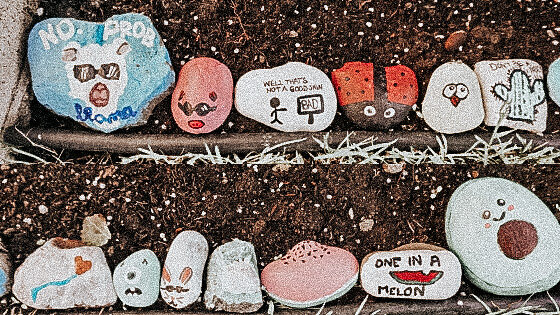
Luckily, my daughter also received her prized dollar store pin-wheel for her birthday, and I received an adorable solar-powered owl for Mother’s Day. My plan with our outdoor space is to be as obnoxious as possible and working out well so far. The only piece of decor I bought was this birdhouse because I thought it would go perfectly with our tree — and it does.

Step 6 – Plant and maintain
Possibly the most intimidating step in gardening is planting. When I did landscaping as a fresh-18-year-old, though, I learned a thing or two about the best ways to plant flowers.
Here are the steps you should take to plant your garden:
-
Find the perfect place for your plant needs. Do you require sun, shade, or partial sun?
-
Dig a spot that has good soil. It’s best to put the plant 6 inches or further into the ground.
-
You should gently tease the soil around the root before placing the plant in the hole for potted plants.
-
Next, fill the gap with soil, and lightly pack the soil in place.
-
Water your plants generously and immediately after planting them.
-
Deadhead as necessary and water daily.
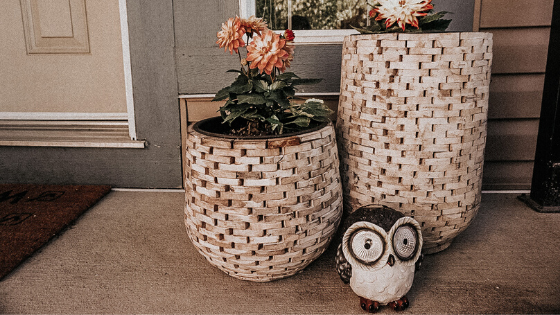
How much did I spend on my ‘affordable garden’?
In total, I went over budget and spent $325 to create and plant my first garden. Can you do it for less? My god, absolutely. I’d be hurt if you didn’t.
To help, and so you can do a little bit of price comparison, here is a breakdown of my full spend:
| Item | Price |
|---|---|
| Annuals | 78.44 |
| Perennials | 14.99 |
| Miracle-Gro | 17.99 |
| Soil | 29.98 |
| Worm Castings | 14.99 |
| Pots | 82.00 |
| Cedar Planter | 69.99 |
| Bird House | 16.99 |
| TOTAL | 325.37 |
Regardless of your budget, creating a home garden can be affordable if you are willing to put in the time and work. A good reminder is the fact that the time you invest will be worthwhile in beautiful flowers and delicious homegrown goodies. Although I didn’t save a ton of money like I initially planned, I had such a fun time creating a space that makes me happy and gives me something to do this summer.
Tell me about your home garden in the comments below!
Oh no, you missed the live webinar! But, good news: Mixed Up Money is pleased to share a resource for anyone planning for a future child or family.
financially preparing for baby
Mixed Up Money is pleased to share a free resource for anyone looking to cut back on non-essential spending. My most-requested product is these monthly calendars to share on your Instagram story, use as a phone background, or print off to track your spending habits.